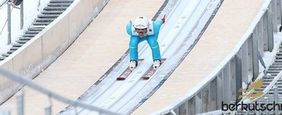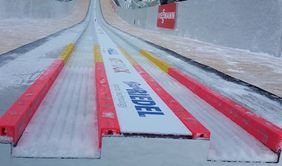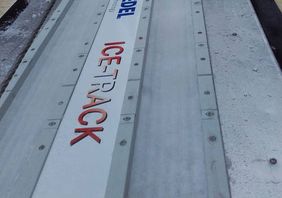The Ski Flying World Championships 2016 was a story of success. Despite difficult conditions the organizers were able to crown two worthy world champion with the likes of Peter Prevc and the team from Norway.
The wind conditions and heavy snowfall had repeatedly brought the jurors and the OC to their limits of possibilities, and even prevented the fourth passage of the individual competition on Saturday to be carried out, which became a rather insignificant hiccup in light of the remaining great rounds.
One of the key factors of this success was the new in-run ice track, a track which was installed almost at the last second before the World Champs, and which is unique to the Kulm.
Cancellation facilitates decision
Originally the Austrian Ski Association ÖSV wanted to do entirely without the modern plastic in-runs. In Bischofshofen and the Bergisel in Innsbruck for example, athletes start on conventional ice tracks (compact, about 25 cm thick blocks of ice that are cooled by an integrated cooling system. The required profile is milled into it by a so-called track milling machine)
In contrast to the conventional tracks, where the whole 25cm high block of ice has to be cooled, with the modern plastic tracks only ??about 7-8cm ice on top of the plastics has to be cooled, requiring much less energy. Especially in rain, mild temperatures and mild winds, the modern plastics system is significantly more resistant to external influences.
After the Kulm cancellation on Sunday last year, when the in-run track stopped working due to heavy rain, although it was protected by a tarpaulin (The moisture had found its way through the ice block from below), along with a dangerous bend in the in-run the demand for a plastic ice track for the World Champs 2016 rose at the last second.
The bend is gone
"For me it was absolutely the right decision and I see the future is set on these modern tracks" says Harald Heim, who was responsible chief of competition during the 2016 World Championships. "After the cancellation of last year we knew that the infamous bend at the startup (this was created at the transition from the concrete part to the steel part of the start-up) could only be removed through very costly measures. We were certain, that the bend or this edge could be eliminated with the installation of the plastic track, that’s what made the decision easier in the end.”
Meets all expectations
"The new track has been operating without any problems," Haim states, looking back to a successful World Championships. "Especially at the flying a calm and trouble-free in-run is an integral part of the flight. If that is not ensured, flying can become dangerous" says Haim.
-----
World's first plastic ice in-run on a flying hill
While the principle of plastic ice track is already widespread on normal and large hills, the installation was a world premiere at the Kulm. "In retrospect, that was a rather delicate matter for us. Although I was convinced from the outset that it works, we had no guarantee, "said Peter Riedel who installed the run-up track at the Kulm. "There are much different parameters compared to the tracks o large hills - above all, the significantly higher speeds of the athletes and the very different forces that are involved in the startup of a large hill. Furthermore there is the 122m length that is for example 17m longer than the Olympic hill in Partenkirchen. We had to use other materials as we would “normally” use for in-runs, more modules were built together, and so on and so on. The difficulty lies in the fact that you cannot test such a track, there is no testing system with this dimension. We must rely on our accumulated experience, which has worked very well at the Kulm”, Riedel concluded.
source: berkutschi.com









